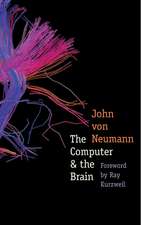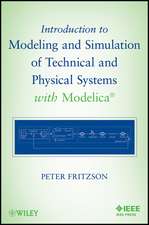Semantics of Parallelism: Non-Interleaving Representation of Behaviour
Autor Michael W. Shieldsen Limba Engleză Paperback – 25 apr 1997
Preț: 654.87 lei
Preț vechi: 818.59 lei
-20% Nou
Puncte Express: 982
Preț estimativ în valută:
125.31€ • 131.18$ • 103.68£
125.31€ • 131.18$ • 103.68£
Carte tipărită la comandă
Livrare economică 05-19 aprilie
Preluare comenzi: 021 569.72.76
Specificații
ISBN-13: 9783540760597
ISBN-10: 3540760598
Pagini: 488
Ilustrații: XIII, 473 p. 10 illus.
Dimensiuni: 155 x 235 x 26 mm
Greutate: 0.68 kg
Ediția:Softcover reprint of the original 1st ed. 1997
Editura: SPRINGER LONDON
Colecția Springer
Locul publicării:London, United Kingdom
ISBN-10: 3540760598
Pagini: 488
Ilustrații: XIII, 473 p. 10 illus.
Dimensiuni: 155 x 235 x 26 mm
Greutate: 0.68 kg
Ediția:Softcover reprint of the original 1st ed. 1997
Editura: SPRINGER LONDON
Colecția Springer
Locul publicării:London, United Kingdom
Public țintă
ResearchCuprins
1. Whys and Wherefores.- 1.1. Why Models of Parallelism ?.- 1.2. Specification in a Variety of Styles.- 1.3. An Overview of the Basic Model.- 1.4. The Contents of the Book.- 2. Behavioural Presentations.- 2.1. Introduction.- 2.2. Examples.- 2.3 Basic Properties of Behavioural Presentations.- Notes.- 3. Discrete Behavioural Presentations.- 3.1. Introduction: Zeno’s Paradoxes.- 3.2. Discreteness.- 3.3. A Characterisation of Discrete Behavioural Presentations.- Notes.- 4. Order Theoretic Properties of Left-Closed Behavioural Presentations.- 4.1. Introduction.- 4.2. Consistent Completeness.- 4.3. Prime Algebraicity.- Notes:.- 5. Event Structures and Closures of Behavioural Presentations.- 5.1 Introduction.- 5.2. Event Structures and Behavioural Presentations.- 5.3. Closure of Behavioural Presentations.- Notes.- 6. Another Event Structure Model.- 6.1 Introduction.- 6.2. The Model.- 6.3. Behavioural Presentations Which Represent Event Structures.- Notes.- 7. Properties of Behavioural Presentations.- 7.1. Introduction.- 7.2. Asynchrony.- 7.3. Left-Closure and Discreteness.- 7.4. Determinacy.- 7.5. Concurrency.- 7.6. Closure.- 8. Karp and Miller Computation Graphs.- 8.1. Introduction.- 8.2. The Model and its Node-Set Sequence Semantics.- 8.3. Behavioural Presentation Semantics.- 8.4. Comparing the Semantics.- Notes.- 9. Trace and Vector Languages.- 9.1. Introduction.- 9.2. Basic Definitions and Properties.- 9.3. Equivalence of the Models.- Notes.- 10. Order Theoretic Properties of Vector Languages.- 10.1. Introduction.- 10.2. Consistent Completeness.- 10.3. Prime Algebraicity.- 10.4. Left-Closed Vector Languages.- 10.5. Parallel Composition.- Notes.- 11. Determinacy.- 11.1. Introduction.- 11.2. Strongly Forward Stable Vector Languages.- 11.3. Simple Vector Languages.- Notes.-12. Linguistic Behavioural Presentations.- 12.1. Introduction.- 12.2. The Structure of BL,A.- 12.3. Strong Forward Stability Revisited.- Notes.- 13. Unambiguous Transition Systems.- 13.1. Introduction.- 13.2. Transition Systems.- 13.3. Properties of Unambiguous Transition Systems.- 13.4. Bisimulation.- 13.5. Computation Graphs Revisited.- Notes.- 14. General Transition Systems.- 14.1. Introduction.- 14.2. Behaviour of Transition Systems.- 14.3. Strong Equivalence.- 14.4. Strict Equivalence.- 15. Asynchronous Transition Systems.- 15.1. Introduction.- 15.2. The Automata.- 15.3. Equivalences. 187 Notes.- 16. Condition/Event Systems: Process and Occurrence Net Semantics.- 16.1. Introduction.- 16.2. Net Theory, C/E Systems and Process Semantics.- 16.3. Occurrence Net Semantics.- Notes.- 17. Condition/Event Systems: Asynchronous Transition System Semantics.- 17.1. Introduction.- 17.2. Asynchronous Transition System Semantics.- 17.3. Comparison of the Semantics: Preliminaries.- 17.4. From Behavioural Presentations to Processes….- 17.5…And Back Again.- 18. Loosely Coupled Systems.- 18.1. Introduction.- 18.2. Pure Loosely Coupled Systems.- 18.3. Loosely Coupled Systems with Transitions.- 19. Categorical Connections.- 19.1. Introduction.- 19.2. Asynchronous Transition Systems.- 19.3. Trace Languages.- 19.4. Discrete Behavioural Presentations.- 20. Categorical Applications.- 20.1. Introduction.- 20.2. Reduction Morphisms.- 20.3. Products.- 21. An Application: Realisation by Nets.- 21.1. Introduction.- 21.2. Conditions for Realisation.- 21.3. Representation of Loosely Coupled Systems.- Notes.- 22. Hybrid Transition Systems.- 22.1. Introduction.- 22.2. The Model.- 22.3. Classes of Hybrid Transition Systems.- Notes.- 23. The Keller Parallel Computation Model.- 23.1.Introduction.- 23.2. The Model and its Transition System Semantics.- 23.3. A Hybrid Transition System Semantics for General.- Nets.- 23.4. Hybrid Transition System Semantics for Parallel Programs.- 23.5. Comparison of the Semantics.- Notes.- 24. From Path Expressions to TCSP.- 24.1. Introduction.- 24.2. Syntax and Marked, Labelled Net Semantics.- 24.3. Hybrid Transition System Semantics.- 24.4. Comparison of the Semantics.- 24.5. Embedding COSY Into TCSP.- Notes.- 25. The Nivat/Arnold Process Model.- 25.1. Introduction.- 25.2. The Model and its Vector Semantics.- 25.3. Process Structure.- 25.4. Hybrid Transition System Semantics.- 25.5. Comparison with the Path/Process Notation.- 25.6. Process Structure and Occurrence Nets.- Notes.- 26. Constructions on Hybrid Transition Systems.- 26.1. Introduction.- 26.2. Recursion.- 26.3 Non-Recursive Constructions.- Notes.- 27. Process Calculus (CCS).- 27.1. Introduction.- 27.2. Syntax and Transition System Semantics.- 27.3. Hybrid Transition System Semantics.- 27.4. Properties of Expressions.- 27.5. Comparison of the Semantics.- Notes.- 28. Theoretical CSP.- 28.1. Introduction.- 28.2. TCSP and its Failure/Divergence Semantics.- 28.3. Hybrid Transition System Semantics.- 28.4. Comparison of the Semantics.- 28.5. Extending the Hybrid Transition System Semantics.- Notes.- 29. Conclusions: Theories of Parallelism.- Appendix. Review of Mathematical Prerequisites.- References.











